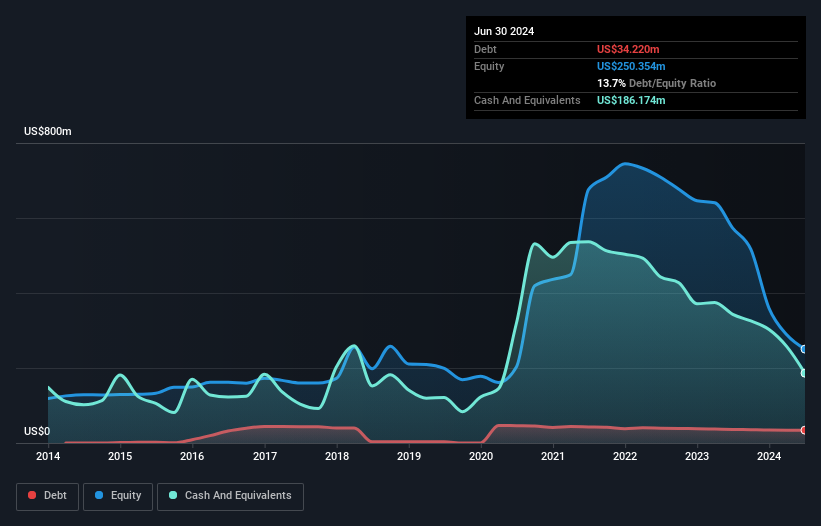
Legendary fund manager Li Lu (who Charlie Munger backed) once said, 'The biggest investment risk is not the volatility of prices, but whether you will suffer a permanent loss of capital.' When we think about how risky a company is, we always like to look at its use of debt, since debt overload can lead to ruin. We note that Beyond, Inc. (NYSE:BYON) does have debt on its balance sheet. But should shareholders be worried about its use of debt?
What Risk Does Debt Bring?
Debt assists a business until the business has trouble paying it off, either with new capital or with free cash flow. Part and parcel of capitalism is the process of 'creative destruction' where failed businesses are mercilessly liquidated by their bankers. However, a more common (but still painful) scenario is that it has to raise new equity capital at a low price, thus permanently diluting shareholders. By replacing dilution, though, debt can be an extremely good tool for businesses that need capital to invest in growth at high rates of return. When we examine debt levels, we first consider both cash and debt levels, together.
Check out our latest analysis for Beyond
How Much Debt Does Beyond Carry?
You can click the graphic below for the historical numbers, but it shows that Beyond had US$34.2m of debt in June 2024, down from US$36.2m, one year before. However, its balance sheet shows it holds US$186.2m in cash, so it actually has US$152.0m net cash.

How Healthy Is Beyond's Balance Sheet?
The latest balance sheet data shows that Beyond had liabilities of US$203.0m due within a year, and liabilities of US$43.4m falling due after that. Offsetting this, it had US$186.2m in cash and US$18.7m in receivables that were due within 12 months. So it has liabilities totalling US$41.6m more than its cash and near-term receivables, combined.
Given Beyond has a market capitalization of US$461.2m, it's hard to believe these liabilities pose much threat. Having said that, it's clear that we should continue to monitor its balance sheet, lest it change for the worse. While it does have liabilities worth noting, Beyond also has more cash than debt, so we're pretty confident it can manage its debt safely. There's no doubt that we learn most about debt from the balance sheet. But ultimately the future profitability of the business will decide if Beyond can strengthen its balance sheet over time. So if you want to see what the professionals think, you might find this free report on analyst profit forecasts to be interesting.
Over 12 months, Beyond made a loss at the EBIT level, and saw its revenue drop to US$1.5b, which is a fall of 7.8%. That's not what we would hope to see.
So How Risky Is Beyond?
We have no doubt that loss making companies are, in general, riskier than profitable ones. And the fact is that over the last twelve months Beyond lost money at the earnings before interest and tax (EBIT) line. Indeed, in that time it burnt through US$162m of cash and made a loss of US$341m. However, it has net cash of US$152.0m, so it has a bit of time before it will need more capital. Overall, we'd say the stock is a bit risky, and we're usually very cautious until we see positive free cash flow. When analysing debt levels, the balance sheet is the obvious place to start. However, not all investment risk resides within the balance sheet - far from it. Be aware that Beyond is showing 2 warning signs in our investment analysis , you should know about...
When all is said and done, sometimes its easier to focus on companies that don't even need debt. Readers can access a list of growth stocks with zero net debt 100% free, right now.
Valuation is complex, but we're here to simplify it.
Discover if Beyond might be undervalued or overvalued with our detailed analysis, featuring fair value estimates, potential risks, dividends, insider trades, and its financial condition.
Access Free AnalysisHave feedback on this article? Concerned about the content? Get in touch with us directly. Alternatively, email editorial-team (at) simplywallst.com.
This article by Simply Wall St is general in nature. We provide commentary based on historical data and analyst forecasts only using an unbiased methodology and our articles are not intended to be financial advice. It does not constitute a recommendation to buy or sell any stock, and does not take account of your objectives, or your financial situation. We aim to bring you long-term focused analysis driven by fundamental data. Note that our analysis may not factor in the latest price-sensitive company announcements or qualitative material. Simply Wall St has no position in any stocks mentioned.
About NYSE:BYON
Beyond
Operates as an e-commerce affinity marketing company in the United States and Canada.
Good value slight.
Similar Companies
Market Insights
Community Narratives



